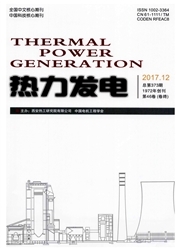

 中文摘要:
中文摘要:
配煤是当前火电厂提高经济效益的主要手段.但劣质煤存在可磨性差,发热量低,相同负荷下给煤量大,易造成磨煤机堵塞等缺陷.工程中发现,磨煤机从正常工作到堵塞要经历一个“临界堵塞”状态的过渡过程,准确判断磨煤机临界堵塞,对机组安全稳定运行意义重大.本文研究一种小波多尺度分解与DGS证据理论相结合的目标模式识别方法,通过机理分析确定原始证据信号;再利用多尺度分解的方法提取证据的特征并将证据在时间域内对齐,进一步通过典型样本构造隶属度函数,获得各证据的信度函数分配;最后运用DGS证据理论得出识别结论.磨煤机实际运行结果表明,该方法有效.
 英文摘要:
英文摘要:
Blended coal combustion is a primary mean to improve economic efficiency of the thermal units. However, due to the poor grindability of low quality coal and their low calorific value, the coal feed quantity will become huger at the same load, which will easily lead to blockage of the coal mills. A transition process called "critical blocking" state between normal state and blocked state has been found in engineering appli- cations. Accurately recognizing the critical blockage state of the medium speed mills is of great significance for units' safe and stable operation. A target pattern recognition was found by wavelet multiscale decompo- sition in combination with the D-S evidence theory, the original evidences were selected after mechanism a- nalysis. Then,the evidences' eigenvalues were extracted and aligned in the time domain by wavelet multi- scale decomposition. Furthermore, membership functions were constructed by typical samples, and the basic probability assignments of each evidences were gotten. Finally, recognition was realized by the D-S evidence theory. The actual operating data were computed to validate the effectiveness of the method.
 同期刊论文项目
同期刊论文项目
 同项目期刊论文
同项目期刊论文
 期刊信息
期刊信息
